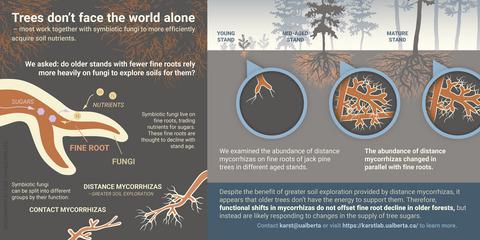Our official English website, www.x-mol.net, welcomes your
feedback! (Note: you will need to create a separate account there.)
Shifts in ectomycorrhizal exploration types parallel leaf and fine root area with forest age
Journal of Ecology ( IF 5.3 ) Pub Date : 2020-08-07 , DOI: 10.1111/1365-2745.13484 Joshua Wasyliw 1 , Justine Karst 1
中文翻译:

外生菌根探索类型随叶龄和细根面积的变化而变化
更新日期:2020-08-07
Journal of Ecology ( IF 5.3 ) Pub Date : 2020-08-07 , DOI: 10.1111/1365-2745.13484 Joshua Wasyliw 1 , Justine Karst 1
Affiliation

|
- The abundance of fine roots and leaves in forests typically peaks during mid‐succession and then declines. If fine root area declines more rapidly than leaf area, this could contribute disproportionately to stand decline. However, trees also partner with symbiotic ectomycorrhizal (EcM) fungi that facilitate nutrient acquisition of fine roots. Ectomycorrhizal fungi can use the carbohydrates provided by their plant partners to produce emanating fungal tissues which increase soil exploration potential but may also prove costly. We suggest two competing hypotheses to frame the response of ectomycorrhizas to stand age: (a) the ‘functional offset’ hypothesis posits that the abundance of ectomycorrhizas with emanating tissues (‘Distance’ mycorrhizas) increases with stand age and (b) the ‘energy‐limited’ hypothesis posits that carbon available for root symbionts decreases with stand age resulting in fewer Distance mycorrhizas. In the first hypothesis, EcM functional traits offset root abundance, while in the second, traits parallel root abundance.
- To test these competing hypotheses, we sampled fine roots to a depth of 90 cm and used allometric equations to estimate changes in root and leaf area index across a chronosequence of Pinus banksiana stands ranging from 2 to 76 years average tree age. We also examined fine roots microscopically to track changes in the abundance of EcM functional types. We used DNA‐based methods to sequence EcM fungi and confirm roots were of P. banksiana.
- Both fine root and leaf area of pine increased for the first 30–36 years (until Mid age) and then plateaued, while the ratio of leaf to fine root area was similar across the age gradient. Also, changes to fine root area with stand age depended on soil depth. The abundance of Distance mycorrhizas was lowest at the youngest plots and increased until Mid age, where it peaked, contrary to the functional offset hypothesis. Instead, the abundance of Distance mycorrhizas paralleled changes to leaf area, aligned with the energy‐limited hypothesis.
- Synthesis. Ectomycorrhizas do not offset the function of roots, rather shifts in exploration type likely reflect adjustments to carbon supply from hosts.
中文翻译:

外生菌根探索类型随叶龄和细根面积的变化而变化
- 森林中优良的根和叶的丰度通常在接班中期达到顶峰,然后下降。如果细根面积的下降速度快于叶面积的下降速度,这可能会导致林分下降的比例过大。但是,树木还可以与共生外生菌根(EcM)真菌合作,促进细根营养的获取。外生菌根真菌可以使用其植物伴侣提供的碳水化合物来产生发散的真菌组织,这增加了土壤勘探的潜力,但也可能证明是昂贵的。我们提出了两个相互竞争的假设,以构架表皮菌根对年龄的反应:(a)'功能性偏移'假说认为发根组织的外生菌根('距离'菌根)的丰度随着林分龄的增加而增加,(b)'能量有限'的假说认为根系共生体可用的碳随着林分龄的增加而减少导致更少的距离菌根。在第一个假设中,EcM功能性状抵消了根的丰度,而在第二个假设中,性状与根的丰度平行。
- 为了检验这些相互竞争的假设,我们对细根进行了采样,深度达90厘米,并使用异速方程估算了在2至76年平均树龄的松木林的时间序列上根和叶面积指数的变化。我们还通过显微镜检查了细根,以追踪EcM功能类型丰富度的变化。我们使用基于DNA的方法对EcM真菌进行测序,并确认其根系为P. bankiana。
- 松树的细根和叶面积在最初的30-36年(直到中年)都先增加,然后趋于平稳,而在整个年龄梯度中,叶与细根面积的比值相似。而且,随着林龄的增长,细根面积的变化取决于土壤深度。距离菌根的丰度在最年轻的地块上最低,直到中年才达到峰值,这与功能补偿假说相反。取而代之的是,距离菌根的丰富性与叶片面积的变化平行,与能量有限的假设一致。
- 综合。外生菌根并不能抵消根的功能,而是勘探类型的变化可能反映了对宿主碳供应的调整。











































 京公网安备 11010802027423号
京公网安备 11010802027423号